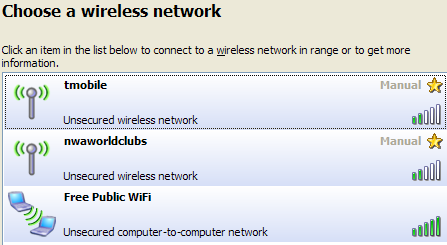Public Wi-Fi is everywhere. Most chain restaurants, fast food places, hotels, coffee shops and airports offer Wi-Fi as a nice bonus for being there. There’s an enormous security risk associated with connecting to any public Wi-Fi, though, so it’s important to be aware of what’s going on.
First, Public Wi-Fi is usually divided into two types: Unsecured and Secured.
Anyone within range can connect to Unsecured Wi-Fi. Sometimes, you can simply connect and go with no sign-in required, but this is considered poor security management. Usually, you will have to agree to some legal stuff and perhaps register for an account before you can connect. In the case of many hotels and airports, you’ll have to pay a fee at this time to connect.
Secured Wi-Fi requires a password before you can even get in. This password is likely at the hotel’s front desk, or available from the coffee shop attendee after making a purchase. Since this connection is password protected, it’s a bit more secure by definition than Unsecured.
Regardless of the type of Wi-Fi you connect to, it’s important to be aware of a few Do’s and Don’ts when out and about on a Wi-Fi enabled device.
- DON’T automatically connect to anything that’s not your home Wi-Fi. You know how your device will auto-connect to anything that says AT&T? Not a good idea. Why? A rogue, invasive Wi-Fi signal can simply name itself after the most commonly used IDs, and devices will stupidly connect to them automatically, opening the device up to hacks.
- Anything that says “Free Public Wi-Fi” is likely a joke at best, and a phishing attempt at worst. Phishing means they are trying to hook you into making a mistake before taking control of your device or planting malware. DON’T connect to anything with this name.
![Notice how Free Public Wi-Fi is peer-to-peer? A clear warning sign not to connect. How to Stay Safe on Public Wi-Fi Networks]()
Notice how Free Public Wi-Fi is peer-to-peer? A clear warning sign not to connect. - DO stick to secured Wi-Fi if possible, or unsecured Wi-Fi that requires a sign-in. Free Wi-Fi that has no sign-in policy is bad news.
- DON’T share files or folders across the public Wi-Fi network, such as in a Guest folder. You don’t want to give anyone else access to anything they’re not supposed to have. If you have File & Folder Sharing or Internet Sharing turned on, turn it off before you connect.
- TRY NOT TO visit any really sensitive websites while on public Wi-Fi, like bank accounts or shopping websites or even personal e-mail. That last one is difficult to avoid, so make sure you’re on the secure version of webmail (noted by the https: in the address and the little lock icon in the corner of your browser).
- DON’T leave your device unattended while in a public setting. Other than the possibility of theft, someone could look up personal info with just a few clicks while you’re away from the table.
- DON’T try to stream video, download gigabytes of data or do anything too Internet hungry, as Public Wi-Fi generally doesn’t have bandwidth to spare. That means you don’t have the upload / download speed you’re used to at home. Airline Wi-Fi even specifically disallows video.
Above all, enjoy the public Wi-Fi, stay safe and be glad you’re not using up your 4G data!
The post How to Stay Safe on Public Wi-Fi Networks appeared first on ReviverSoft Blog.




















